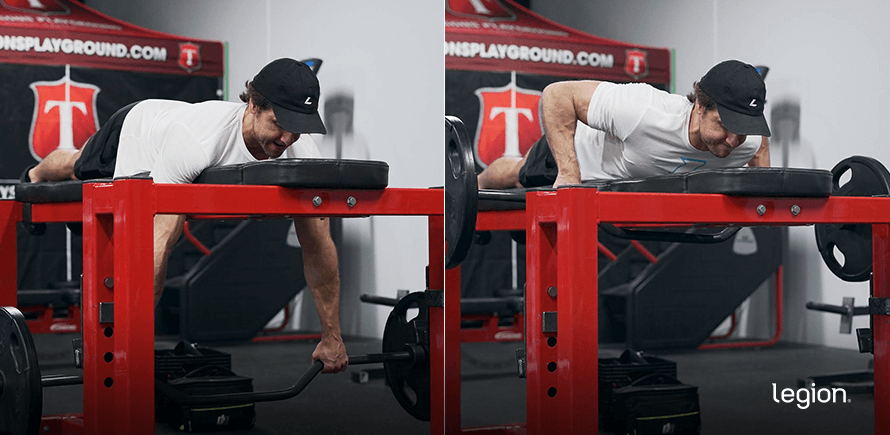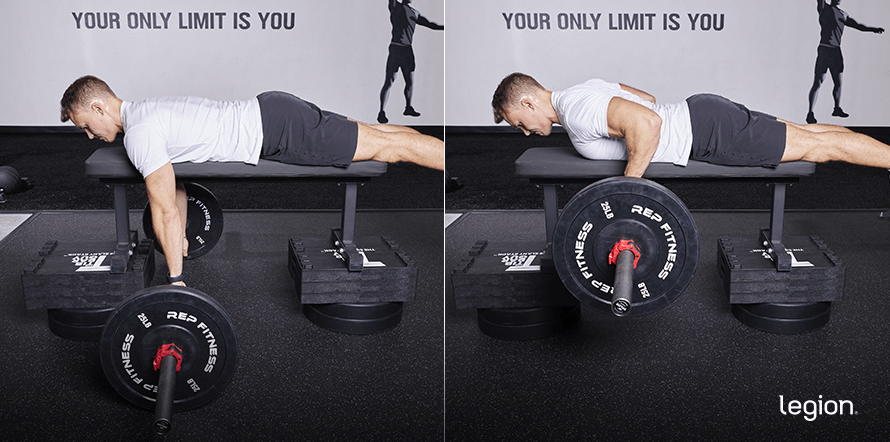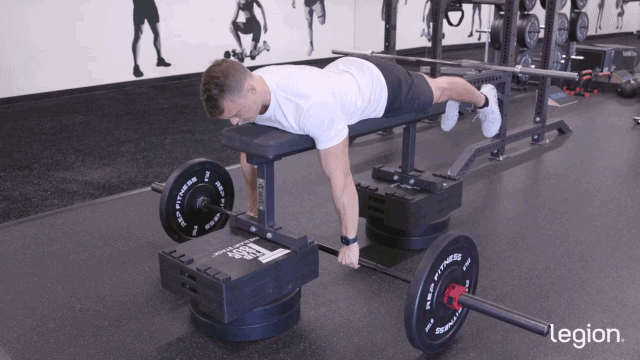How to Do the Seal Row to Build Back Muscle and Strength
If you want to build a broad, strong back, the seal row should be part of your training arsenal.
It’s so effective because it allows you to train your entire back with heavy weights while minimizing stress on your spine, so you can gain muscle and strength without wearing yourself out.
Because you lie on a bench to perform the seal row, you can’t use momentum to help lift the weights, either, which ensures your back muscles work hard and get an excellent muscle-building stimulus.
The only downside is that setting up and performing the seal row can seem tricky at first. However, this article will provide all the know-how you need to overcome this.
You’ll also discover the many ways to configure the seal row exercise, how to perform it correctly, which muscles it works, why it’s beneficial, the best seal row alternatives and variations, and more.
- What Is the Seal Row Exercise?
- Seal Row Configurations: Seal Row Bench, Bar & Attachment
- How to Do the Seal Row
- 1. Set up
- 2. Row
- 3. Descend
- Seal Row: Muscles Worked
- Seal Row: Benefits
- 1. It puts little stress on your spine.
- 2. It trains your entire back.
- 3. It prevents you from cheating.
- The Best Seal Row Alternatives & Variations
- 1. Dumbbell Seal Row
- 2. Batwing Row
- 3. Incline Seal Row
- Seal Row Exercise FAQs
- FAQ #1: Are seal rows worth it?
- FAQ #2: What is the difference between a Pendlay row and a seal row?
- FAQ #3: Why are seal rows so hard?
Table of Contents
What Is the Seal Row Exercise?
The seal row is a barbell back exercise done while lying face down on a bench. You row the barbell toward your torso until it touches the bottom of the bench, then lower it until your arms are straight.
The set-up for the seal row exercise depends on what equipment you have available. Most commercial gyms don’t have the “ideal” set-up, which includes a dedicated seal row bench, seal row bar, or seal row attachment.
Instead, most people use standard gym equipment to elevate a bench off the floor, which allows you to perform the exercise with a full range of motion.
Seal Row Configurations: Seal Row Bench, Bar & Attachment
The most common way to configure the barbell seal row (and the method we’ll focus on in this guide) is to raise a flat bench off the floor using weight plates, plyo boxes, or aerobics steps and position a straight barbell under it.
That said, some gyms have specialized equipment that simplifies the set-up and makes performing the seal row easier, such as:
- Seal row bench: A seal row bench is a high weightlifting bench that allows your arms to hang straight down without the weights touching the floor. Seal row benches also have hooks similar to a squat rack that make unracking and reracking the barbell easier.
- Seal Row Barbell: A seal row barbell is a cambered barbell. People prefer a seal row bar to a straight bar because its shape allows you to pull the bar higher toward your torso without it hitting the bench, thereby extending the exercise’s range of motion.
- Seal Row Attachment: A seal row attachment is a small pad that attaches to a power rack and allows you to perform barbell seal rows while standing. While not quite the same as a seal row bench, a seal row attachment is cheaper and smaller, making it a good alternative for people who train in a home gym and don’t have space for a dedicated seal row bench.
In other words, if you’re looking for the perfect seal row set-up in a gym, look for one that has a seal row bench and barbell, like this:

And if you’re looking to do seal rows in a home gym, invest in a seal row attachment for your squat or power rack.
How to Do the Seal Row
To master seal row form, split the exercise into three parts: set up, row, and descend.

1. Set up
Raise a flat bench 6-to-12 inches off the floor by placing it on weight plates, plyo boxes, or aerobics steps, then position a straight barbell under it.
Load the barbell with weights, then lie prone on the bench so that your eyes are level with the top of the pad. Grip the barbell with a pronated grip (palms facing your feet) slightly wider than shoulder-width apart.
2. Row
Pull the barbell toward your upper body until it touches the underside of the bench, keeping your elbows 6-to-10 inches from your sides. As you row the bar, pull your shoulder blades together.
3. Descend
Reverse the movement and return to the starting position.
Here’s how it should look when you put it all together:

Seal Row: Muscles Worked
The main muscles worked by the seal row exercise are:
- Latissimus dorsi (“lats”)
- Trapezius (“traps”)
- Rhomboids
- Teres major and minor
- Infraspinatus
- Posterior deltoids (“rear delts”)
It also trains your biceps and forearms to a lesser degree.
Here’s how the main muscles worked by the seal row look on your body:

Seal Row: Benefits
1. It puts little stress on your spine.
Since your spine doesn’t support the weight during a seal row, it’s a comfortable exercise for people managing or training around back issues.
Additionally, people usually find exercises that put minimal stress on the spine easier to recover from than those that tax the lower back, so you can perform the seal row more frequently than many back exercises without wearing yourself to a frazzle.
2. It trains your entire back.
Research shows that horizontal pulling exercises, like the seal row, train your entire back, including your lats, rhomboids, traps, rear delts, infraspinatus, and teres major and minor.
Exercises that train several muscle groups simultaneously are called compound exercises, and they’re useful because they allow you to lift heavy weights safely, which is generally better for muscle and strength gain.
They’re also time-efficient since you don’t have to do several exercises to train each muscle group separately.
3. It prevents you from cheating.
Lying on a bench prevents you from generating momentum with your hips and upper body to “cheat” the weight up.
This forces your back muscles to do the majority of the work, which ensures they’re sufficiently stimulated by the exercise.
The Best Seal Row Alternatives & Variations
1. Dumbbell Seal Row
The dumbbell seal row is almost exactly the same as the barbell seal row—the only difference is you use dumbbells instead of a barbell. As such, you can think of the dumbbell and barbell seal rows as interchangeable—do whichever you have equipment for or prefer.
2. Batwing Row
The batwing row is a dumbbell seal row performed on a weightlifting bench that isn’t raised off the floor. You also perform a 2-to-3-second hold at the top of each rep. The focus of this variation is not lifting heavy weights. Rather, it’s a seal row alternative to help you practice and strengthen scapula retraction (pulling your shoulder blades together as you row).
3. Incline Seal Row
Alternating between regular seal rows and incline seal rows (also called “chest-supported rows”) every 8-to-10 weeks of training (or longer) can lead to better results than doing just one kind of seal row. This is because each variation trains your back from different angles and through different ranges of motion, producing more balanced muscle growth compared to sticking with just one type.
Seal Row Exercise FAQs
FAQ #1: Are seal rows worth it?
Yes, seal rows are worth including in your workout routine. While they’re tricker to set up than other back exercises, they allow you to train with heavy weights safely and progress regularly, making them excellent for gaining muscle and strength.
Because you don’t load your spine, they’re also less fatiguing than other bent-over row variations, so you can perform them more often without causing excessive fatigue.
FAQ #2: What is the difference between a Pendlay row and a seal row?
The main difference between the Pendlay row and the seal row is the form. In a Pendlay row, you stand with your back as close to parallel to the floor as possible and pull a barbell from the floor to your torso.
In contrast, a seal row involves lying face down on a bench and pulling the barbell to the underside of the bench.
Because of these differences, the Pendlay row trains your lower back more than the seal row. Conversely, the seal row places no stress on your lower back, making it more suited to people with lower back issues or those who want to limit lower back fatigue.
FAQ #3: Why are seal rows so hard?
Seal rows are challenging because they prevent you from using your hips or upper body to generate momentum, which forces your upper back and lats to do more work.
The post How to Do the Seal Row to Build Back Muscle and Strength appeared first on Legion Athletics.
https://ift.tt/rIFf31Q May 27, 2024 at 06:00PM Legion Athletics
Comments
Post a Comment